18.1: Current Conservation of Nonhuman Primates
- Page ID
- 158846

Diversity of Primates
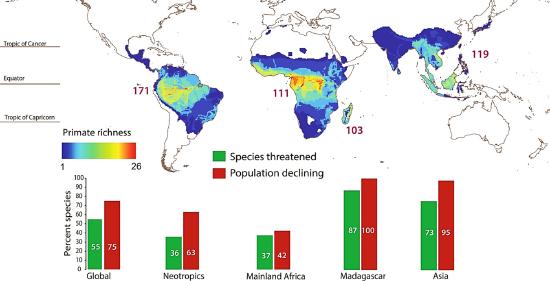 Figure \(\PageIndex{2}\): The global distribution and species richness of primates and the percentage of those threatened with extinction and declining populations. The numbers next to each geographic area indicate the current species present in that location. The bars below show the percentage of species threatened with extinction (in green) and the percentage of species with declining populations in each region (in red).
Figure \(\PageIndex{2}\): The global distribution and species richness of primates and the percentage of those threatened with extinction and declining populations. The numbers next to each geographic area indicate the current species present in that location. The bars below show the percentage of species threatened with extinction (in green) and the percentage of species with declining populations in each region (in red).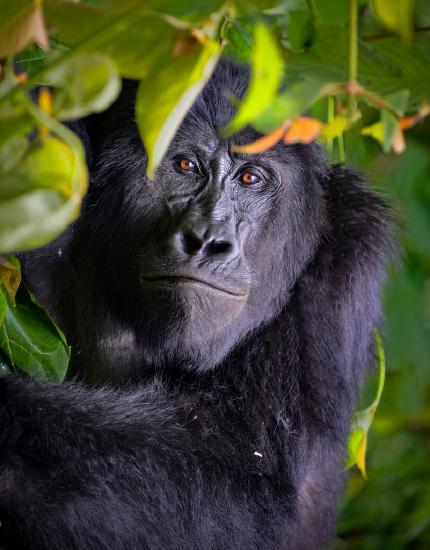 Figure \(\PageIndex{3}\): Mountain gorilla (Gorilla beringei beringei) in Bwindi Impenetrable National Park, Uganda. Mountain gorillas are classified as endangered and are only found in the Virungas area of Rwanda and the Democratic Republic of Congo and the Bwindi forest of Uganda (Hickey et al. 2018; Kalpers et al. 2003). This species has suffered tremendously due to habitat destruction, poaching, political unrest, and war (Kalpers et al. 2003).
Figure \(\PageIndex{3}\): Mountain gorilla (Gorilla beringei beringei) in Bwindi Impenetrable National Park, Uganda. Mountain gorillas are classified as endangered and are only found in the Virungas area of Rwanda and the Democratic Republic of Congo and the Bwindi forest of Uganda (Hickey et al. 2018; Kalpers et al. 2003). This species has suffered tremendously due to habitat destruction, poaching, political unrest, and war (Kalpers et al. 2003).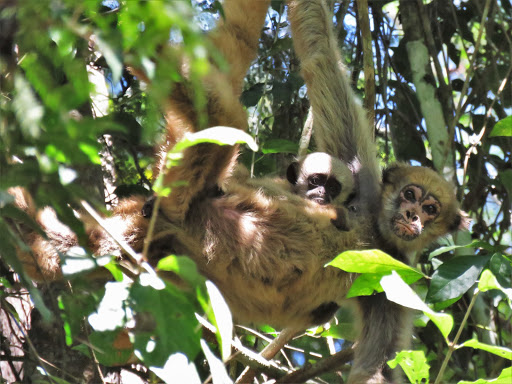 Figure \(\PageIndex{4}\): A female northern muriqui (Brachyteles hypoxanthus) with infant at the Feliciano Miguel Abdala Private Natural Heritage Reserve outside of Caratinga, Brazil. Muriquis are found exclusively in the Atlantic Forest of southeastern Brazil. The destruction and fragmentation of these forests have caused this species to be listed as Critically Endangered (Strier et al. 2017). Although still threatened, the continued efforts of the Muriqui Project of Caratinga have brought this species back from the brink of extinction.
Figure \(\PageIndex{4}\): A female northern muriqui (Brachyteles hypoxanthus) with infant at the Feliciano Miguel Abdala Private Natural Heritage Reserve outside of Caratinga, Brazil. Muriquis are found exclusively in the Atlantic Forest of southeastern Brazil. The destruction and fragmentation of these forests have caused this species to be listed as Critically Endangered (Strier et al. 2017). Although still threatened, the continued efforts of the Muriqui Project of Caratinga have brought this species back from the brink of extinction.International Union for the Conservation of Nature (IUCN)
| Critically Endangered (CR): Facing an extremely high risk of extinction in the wild due to any of the following: |
Identifying Priorities in Primate Conservation
PRIMATE SIGNIFICANCE
Ecological Significance of Primates
Primates play a key role within their ecosystems, often acting as important contributors to forest community structure by aiding in seed dispersal and pollination of angiosperms and other plant species. Variability in traits such as diet, gut anatomy, and movement patterns influence the spatial landscape of dispersed seeds (Russo and Chapman 2011). Frugivorous primates that range widely are considered the greatest contributors to the dispersal of seeds, as they often either swallow seeds whole, as is common for most Neotropical frugivorous primates (Figure 18.1.5), or spit seeds out, as is common for primates with cheek pouches in Africa and Asia. These primates can contribute greatly to the diversification and regeneration of forest communities by traveling long distances after consumption and depositing seeds away from the parent plant within heterogeneous landscapes (Strier 2017; Terborgh 1983). Frugivory and seed dispersal are critical plant-animal relationships (Russo 2017). Bach Thanh Hai and colleagues (2018) found that yellow-cheeked crested gibbons (Nomascus gabriellae) in Southeast Asia were the most effective seed disperser for the Pacific walnut tree. Gibbons dispersed seeds via consumption anywhere from 4 m to 425 m from the parent tree. Seeds defecated by gibbons had higher germination and success rates than those spit by macaques in the same forest.
Some species of primate may also act as pollinators for local plant species. These primates are attracted to the nectar and flowers of the plant, which often leave pollen on their faces and fur, subsequently spreading pollen to conspecifics when the primate moves to a new location. Jeremy Hogan and colleagues (2016) suggest that white-faced capuchins (Cebus capucinus imitator) may have a beneficial effect on certain plant species in Costa Rica. Other primates may have co-evolved a plant-pollinator relationship. Data indicate that the black and white ruffed lemur (Varecia variegata) is reliant on the nectar of the traveler’s palm (Ravenala madagascariensis) during specific times of the year, allowing pollen to stick to the ruff of their necks. This, along with the notion that no other species visit the travel’s palm during certain times of the year, indicate that this plant species may be dependent on nonflying mammals for pollination (Kress et al. 1994).
By acting as seed dispersers and pollinators, primates can aid in the reproductive success, regeneration, and diversification of plants within their ecosystems. The significance of these relationships is only becoming more apparent as habitats continue to be fragmented and destroyed. As habitats dwindle, the ability to regenerate healthy forest systems is crucial to the health and survival of tropical forest systems worldwide (Stier 2017).
Bioanthropological Significance of Primates
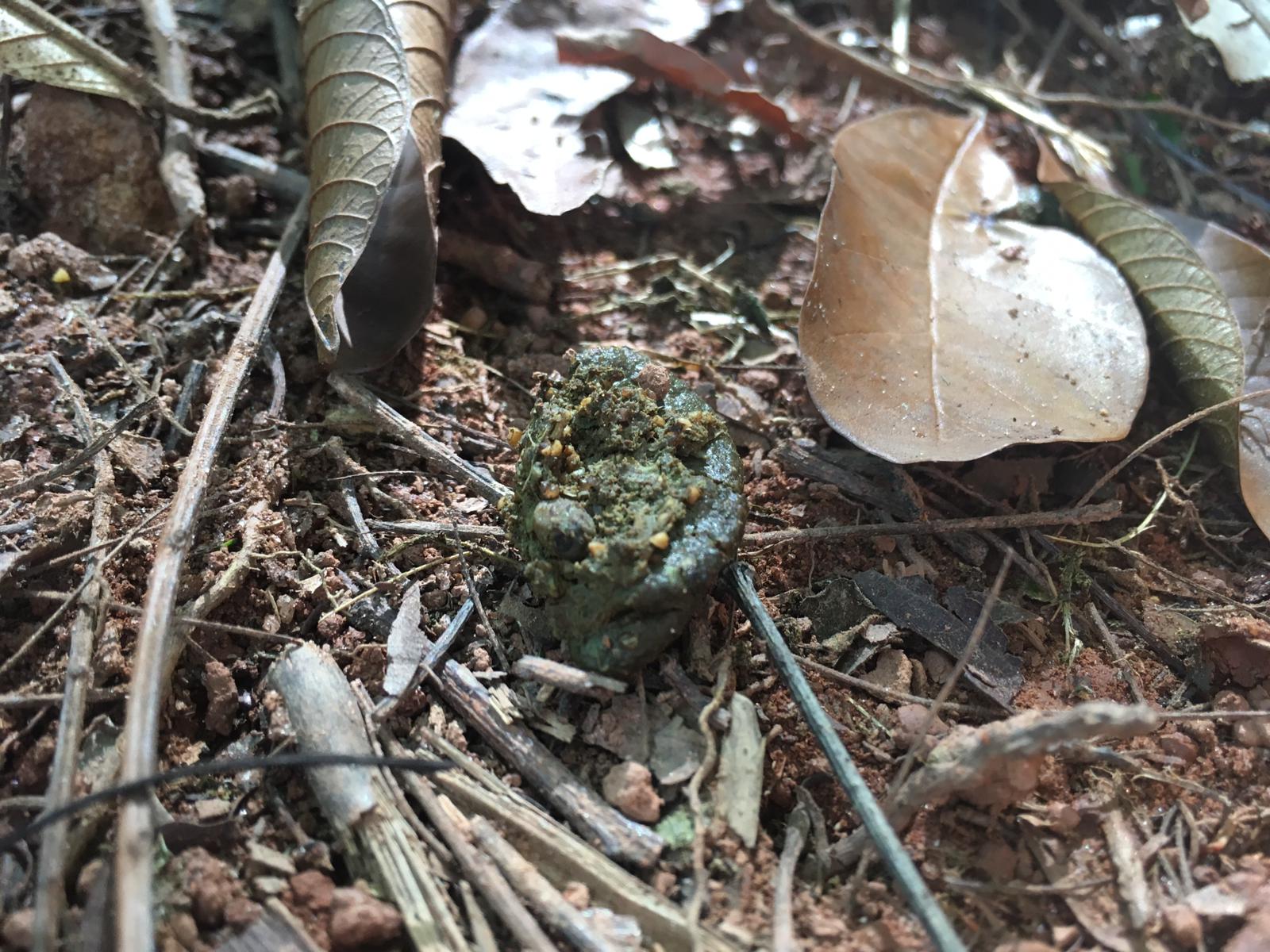
The study of non-human primates has been an integral component of anthropology for many decades. Even before Sherwood Washburn advocated in The New Physical Anthropology (1951) that primates could be studied as living reference for hominin behaviors, anthropologists like Margaret Mead recognized that studies of wild primates could contribute to biological and sociocultural anthropology in many ways (Strier 2011b). Primatology in Japan, the U.S., and Europe grew out of a desire to better understand ourselves. Thus, research in the 1960s and 1970s largely focused on species such as chimpanzees (Pan spp.) or baboons (Papio spp.) that are closely related to humans phylogenetically or live in environments similar to those occupied by early hominins (Haraway 1991; Strum and Fedigan 1999; Washburn 1973). Since those early days, biological anthropological primatology has broadened to include primates from around the world (Strier 2003, 2018a). The inclusion of diverse taxa from what were then-understudied regions challenged notions of “typical” primate behavior, such as the idea that aggression was the main mechanism for maintaining hierarchical social relationships (Strier 1994).
Anthropologists draw broadly from primate studies to explore the many facets of human behavior and evolution. For example, studies demonstrating the tool-using capabilities of wild chimpanzees (Pan troglodytes) and capuchin monkeys (Sapajus spp., formerly Cebus spp.) show that similar ecological pressures and intelligence contribute to tool-using behaviors, rather than just phylogenetic relatedness to humans (Fragaszy et al. 2004; Inoue-Nakamura and Matsuzawa 1997). Similarly, studies of modern primate morphology are frequently used to assess how locomotor style or behaviors (such as foraging) are related to anatomy, and this knowledge can then be used to assess the skeletal and dental anatomy of fossil hominins. Studies of microscopic wear patterns, for example, use living primates as analogues to understand wear patterns generated by different food items as well as the rapidity with which changes to these patterns can occur (Teaford and Oyen 1989; Ungar and Sponheimer 2011). Living nonhuman primates provide a comparative sample with which we deepen our understanding of the evolutionary mechanisms that shaped human evolution.
Cultural Significance of Primates
For as long as our species has existed, groups of people have lived alongside nonhuman primates and engaged with them in varying ways (Fuentes 2012). The development and expansion of the field of ethnoprimatology, the study of the human–nonhuman primate interface, has encouraged researchers from sociocultural anthropology and primatology to investigate these points where primates and humans interact and influence each other in surprising ways (Fuentes 2012; Sponsel 1997). Primates are viewed by many as exceptional animals for the ways in which they reflect elements of humanness, stimulating many thousands of people to observe their exhibits at zoos and sanctuaries throughout the world. However, the significance of these animals to diverse cultures goes beyond anthropocentrism and touches on aspects of ecology, religion, and social systems. Primates are common figures in religion and myth, appearing sometimes as gods or deities themselves (e.g., the Hindu deity Hanuman) and sometimes as mediators between the human and spirit realms (Alves et al. 2017; Peterson 2017; Wheatley 1999). Primates have additional cultural significance as figures in folklore and legend, and they are often ascribed human-like characteristics in many of these narratives (Cormier 2017). These stories often inform local taboos that may discourage the consumption of particular species or deforestation of particular areas (Osei-Tutu 2017; Roncal et al. 2018; Sicotte 2017).
The role that primates play in human cultures is complex and varies significantly with local history, religious practice, and economies. Among the Awa Guajá of eastern Amazonia, for example, primates are considered a part of the humans’ extended kin network and are protected as such, yet they also constitute an important source of dietary protein and are hunted regularly (Cormier 2003). In other primate habitat countries, such as Bali, primates play a significant role in religious practice. Long-tailed macaques (Macaca fascicularis) in Bali are frequently found in the forests surrounding Hindu temples and will consume offerings left by residents and tourists once festivals or rituals are concluded (Fuentes 2010; Wheatley 1999). These macaques are seen by some as mediators between the natural world and the spiritual world that transports offerings from one realm to another (Wheatley 1999). Investigating how local residents view primates—for example, whether species are considered sacred or not—is a vital component of conservation programs in these areas (Peterson and Riley 2017). Studying the interface between human and nonhuman primates, and what factors (e.g., local religious practices, taboos, etc.) influence these interactions can lead to more holistic conservation planning and implementation.
Economic Significance of Primates
One of the most promising ways that primates can benefit people is through the potential to stimulate local economies from ecotourism. Ecotourism differs from traditional tourism in three main ways: it focuses on nature-based attractions, it provides learning opportunities, and its tourism management practices adhere to economic and ecological sustainability (Fennell and Weaver 2005). Primates are charismatic megafauna, meaning that they are large animals (oftentimes mammals) that elicit mass appeal. They have the possibility to draw tourists, which can in turn bring revenue to lower-income communities found near primate habitats. This attraction from tourists, along with revenue-sharing, can then stimulate local populations to have more positive attitudes toward protected areas and become more invested in the well-being and protection of primates and their habitats (Archabald and Naughton-Treves 2001).
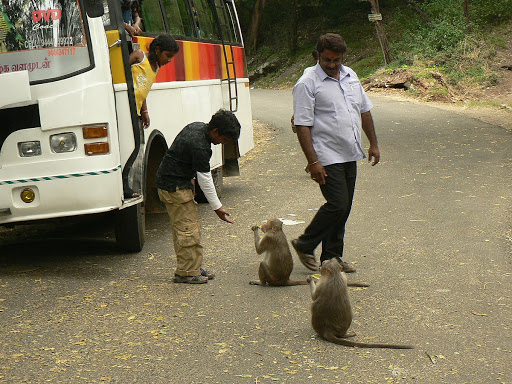
Perhaps one of the greatest success stories of nature-based tourism revolves around the mountain gorillas (Gorilla beringei beringei) of Rwanda. After internal conflict plagued Rwanda during the 1990s, the Virungas area developed gorilla-based tourism as a means to aid in socioeconomic development and to bring stability to the region. This process not only helped to increase mountain gorilla populations but was also able to generate enough income to cover the operation costs of three national parks (Maekawa et al. 2013). Research indicated that low-income individuals living around Parc National des Volcans in Rwanda could garner direct income as well as nonfinancial benefits (such as the development of schools and hospitals) from gorilla tourism in the region (Spencely et al. 2010). Although ecotourism has the potential to alleviate poverty situations for local populations and aid in the overall sustainability of natural habitats, it can also bring a suite of new problems to areas. It can overcrowd national parks and over-habituate primates (Figure 18.1.6), increase potential disease transfer between humans and primates, and exacerbate corruption, which often pulls money away from local communities (Hvenegaard 2014; Muehlenbein et al. 2010).

